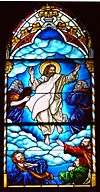Healing the deaf mute of Decapolis
Healing the deaf mute of Decapolis is one of the miracles of Jesus in the Gospels, namely Mark 7:31-37.[1] Its narration offers many parallels with the healing of the blind man of Bethsaida in Mark 8:22-26.
According to the Gospel of Mark, when Jesus entered the region of the Decapolis after passing through Sidon and down the Sea of Galilee, some people brought to him a man who was deaf and could hardly talk, and they begged Jesus to place his hand on him. The Gospel of Mark then states:
33 After he took him aside, away from the crowd, Jesus put his fingers into the man's ears. Then he spit and touched the man's tongue. 34 He looked up to heaven and with a deep sigh said to him, "Ephphatha!" (which means "Be opened!"). 35 At this, the man's ears were opened, his tongue was loosened and he began to speak plainly. Jesus commanded them not to tell anyone. But the more he did so, the more they kept talking about it. People were overwhelmed with amazement. "He has done everything well," they said. "He even makes the deaf hear and the mute speak."
Commentator of Mark, Lamar Williamson, writes that this is the last unit in a series of miracles concerned with the identity of Jesus, as earlier confirmed by Apostle Peter's christological affirmation in Mark 8:29 where Peter exclaimed: "You are the Messiah".[2]
See also
- Life of Jesus in the New Testament
- Ministry of Jesus
- New Testament places associated with Jesus
- Parables of Jesus
- Muteness
References
- ↑ Biblegateway Mark 7:31-37
- ↑ Lamar Williamson 1983 Mark ISBN 0-8042-3121-4 pages 138-140
